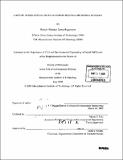A mouse model for studying gastrointestinal microbial ecology
Author(s)
Sarma-Rupavtarm, Ramahi Bhushan, 1977-
DownloadFull printable version (9.707Mb)
Other Contributors
Massachusetts Institute of Technology. Dept. of Civil and Environmental Engineering.
Advisor
Martin F. Polz.
Terms of use
Metadata
Show full item recordAbstract
The mammalian gastrointestinal (GI) tract harbors a complex microbial ecosystem with hundreds of bacterial species at total levels as high as 10¹¹⁻¹² cells/g tissue. These bacteria play an important role in the health of the host as well as in causing disease, but studies on the roles of the GI microflora are hindered by the lack of a suitable model system. This thesis characterizes and uses a defined flora mouse model to study interactions between exogenous bacteria and the GI microflora. The first part of the thesis characterizes a defined flora mouse model consisting of immunodeficient C.B-17 SCID mice colonized with the eight bacterial strains of the altered Schaedler flora (ASF). Specific and sensitive molecular methods were developed to accurately estimate the levels of different ASF strains. Distribution of specific ASF strains along the GI tract was dependent on the oxygen tolerance of the strains. Fecal levels of different strains, which are typically used as a model for colonic bacteria, were different from colonic levels, although all colonic strains were present in feces. ASF strains were persistent in the mouse GI tract even in the face of long-term exposure to other bacteria. The second part of the thesis evaluates the presence of different ASF strains in inbred and outbred mouse models from different vendors to establish the potential for widespread use of these strains as representatives of the mouse GI microflora. Seven of the eight strains were persistent in both inbred and outbred mice from all vendors studied. This indicates the potential for the ASF strains to be used as a model system even in mouse models that do not harbor a defined flora. (cont.) The third part of the thesis explores ecological interactions following infection by an intestinal pathogen, Citrobacter rodentium, in defined flora C.B-17 SCID mice. Bulk levels of the pathogen and the ASF strains in different regions of the large intestine and their spatial localization across the luminal-mucosal cross-section were assessed. C. rodentium exhibited accelerated dynamics, and infection was followed by increases in levels of specific ASF strains and in total bacterial levels in infected mice as compared to control mice. Different ASF strains were observed to have specific spatial niches that did not vary between infected and control mice. These results suggest that the role of the microflora in preventing colonization of pathogens is a complex process that potentially involves more than one bacterial species.
Description
Thesis (Ph. D.)--Massachusetts Institute of Technology, Dept. of Civil and Environmental Engineering, 2005. Includes bibliographical references (p. 131-133).
Date issued
2005Department
Massachusetts Institute of Technology. Department of Civil and Environmental EngineeringPublisher
Massachusetts Institute of Technology
Keywords
Civil and Environmental Engineering.